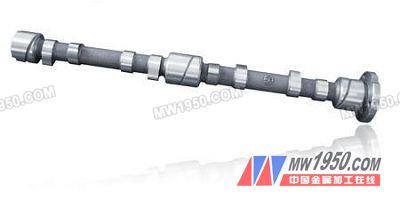Cold-excited cast iron products have been developed in Europe and the United States in the early 1920s. They were widely promoted in the 1960s and 1970s, and the technology in the 1980s was fully mature. Cold-excited cast iron products are widely used in internal combustion engines because of their low cost and high performance.
The camshaft is an indispensable and important component in the valve train of the internal combustion engine. Its function is to control the movement of the valve and to open and close according to a certain working order and time. Therefore, it must have excellent wear resistance. At present, the camshafts commonly used in China are made by medium carbon steel surface quenching and ductile iron isothermal quenching.
In foreign countries, 43% to 47% of gasoline engines and diesel engines in the internal combustion engine industry use cold-excited cast iron as the camshaft material. Cold-excited cast iron is widely used as a camshaft material for its low cost and high performance.
First, the performance and application of cold-excited cast iron camshaft
Cold-excited cast iron has good abrasion resistance and scratch resistance due to its high hardness of carbide structure. The white layer in the cold-excited cast iron is a Leysite structure, which is a mechanical mixture of pearlite and carbide at normal temperature, and it plays a skeleton role because it contains a large amount of carbide. The hardness is higher, and the spheroids in the Leysite function to store oil. The wear resistance, wear reduction and oil storage of this rod have been widely recognized and applied in the internal combustion engine industry.

Second, technical parameters and processes
The cold-excited cast iron camshaft is made by adding a certain amount of alloying elements to the HT250 and casting it through a special casting process. The addition of alloying elements improves the hardness and comprehensive mechanical properties of the camshaft matrix and greatly improves the wear resistance. The wear amount of the cold-excited cast iron is only about 12% of the 45# steel and other camshafts of the ductile iron.
1. Mechanical properties tensile strength ób>250N/mm2
2, hardness HRC48 ~ 54
3, the wear layer depth of 6 ~ 10mm
Third, due to the current use of ductile iron and 45# steel, austempering or induction hardening is used to obtain martensite structure. After high-speed operation, early wear occurs in the cam tip, while the cold-excited cast iron uses a special molding process without heat treatment. The various hardness values ​​required for each part of the camshaft are obtained. The wear of the peach tip is only 1/7 of that of ductile iron and 45# steel, and it has the advantages of reducing processing cost and improving economy.
Polymeric Ferric Sulfate,Chemicals Product,High Purity Polyferric Sulfate
Ferrous Sulfate Co., Ltd. , http://www.nssulphate.com